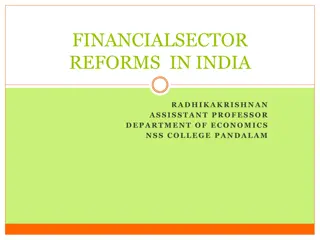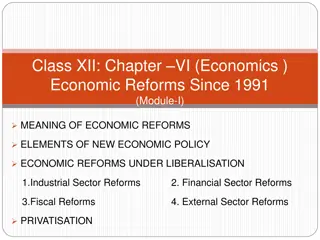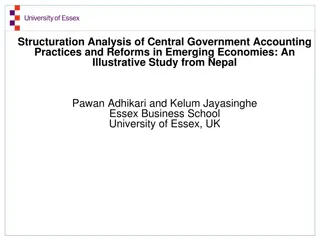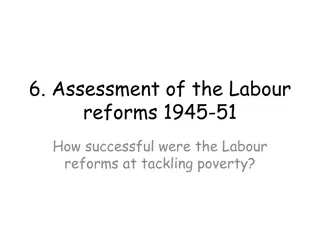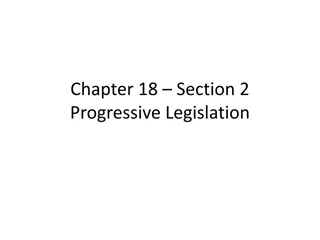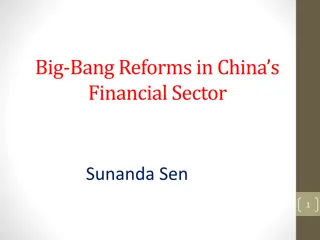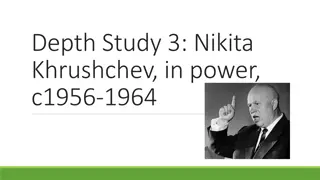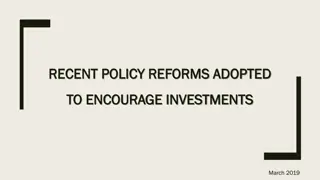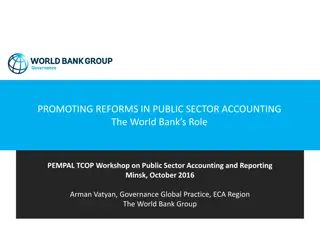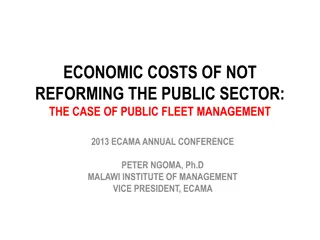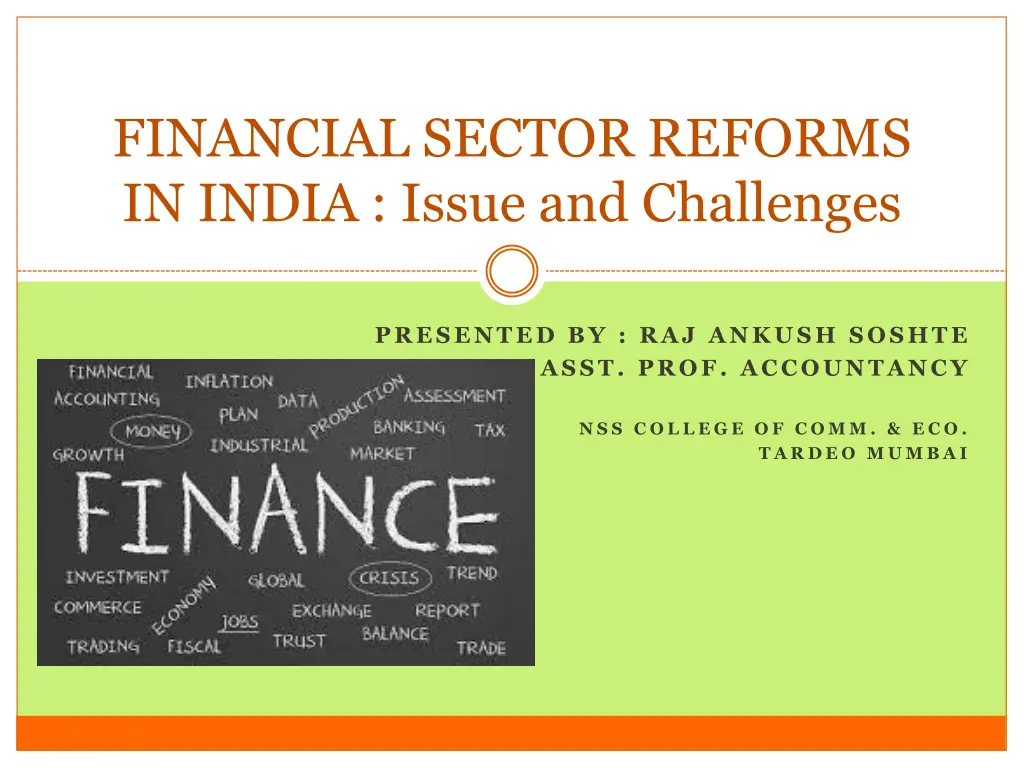
Challenges and Reforms in India's Financial Sector
Explore the issues and reforms in India's financial sector, addressing key challenges such as removing financial repression, promoting efficiency, enabling price discovery, and enhancing international competitiveness. Discover the growth of the Indian economy, corporate liabilities, banking sector reforms, and capital market reforms driving financial stability and development.
Download Presentation

Please find below an Image/Link to download the presentation.
The content on the website is provided AS IS for your information and personal use only. It may not be sold, licensed, or shared on other websites without obtaining consent from the author. If you encounter any issues during the download, it is possible that the publisher has removed the file from their server.
You are allowed to download the files provided on this website for personal or commercial use, subject to the condition that they are used lawfully. All files are the property of their respective owners.
The content on the website is provided AS IS for your information and personal use only. It may not be sold, licensed, or shared on other websites without obtaining consent from the author.
E N D
Presentation Transcript
FINANCIAL SECTOR REFORMS IN INDIA : Issue and Challenges PRESENTED BY : RAJ ANKUSH SOSHTE ASST. PROF. ACCOUNTANCY N S S C O L L E G E O F C O M M . & E C O . T A R D E O M U M B A I
Financial sector reform process Remove financial repression that existed earlier, Create an efficient, productive and profitable financial sector industry Enable price discovery, particularly, by the market determination of interest rates that then help in efficient allocation of resources, Provide operational and functional autonomy to institutions Prepare the financial system for increasing international competition Open the external sector in a calibrated fashion Promote the maintenance of financial stability even the face of domestic and external shocks.
Lowering SLR and CRR Prudential norms Capital Adequacy Norms (CAN) Deregulation of Interest Rates Recovery of debts due to Banks and Financial Institutions Act 1993 New private sector banks Scheduled Commercial Banks are given freedom to open new branches and upgrade extension counters RBI has set up a Board of financial Supervision
Permission to banks to diversify business activities Phasing out of directed redefinition of priority sector Asset classification into 4- Standard or performing assets, sub-std assets (remains NPA forless than 18 months)doubtful assets (excd 18 months) and loss assets (cannot be recovered) Banking ombudsman scheme 1995 Banks were asked to disclose and share any information regarding defaulting borrowers to improve the recovery and discipline among borrowers. Banks were required to categorize their assets into performing and non performing. credit programmes and
CAPITAL MARKET REFORMS Securities and Exchange Board of India (SEBI) as the regulator of equity market in India. permission granted to the private sector firms to start Mutual Funds. Indian capital market has been opened up for foreign institutional institutions (FII). Indians have been allowed to invest in the equity capital of the Indian companies, stock market and can also invest in government securities
banks have been allowed to lend against various capital market instruments Establishment of Creditors Rating Agencies : The Investment Information & Credit Rating Agency of India. Limited (ICRA - 1991) The Credit Rating Information Services of India Limited (CRISIL - 1988) & Credit Analysis and Research Limited (CARE) were set up
Depositories Act was passed in 1996 and NSDL and CDSL estd Stock exchanges were demutualised. (owned and operated by shareholders and not by traders) Many Indian & foreign commercial banks have set up their MBD (Merchant Banking Divisions) in the last few years. The Insurance Regulatory Authority (IRDA) was set up in 2000. & Development
IMPACT OF CAPITAL MARKET REFORMS New and innovative Fin.instruments Active participation of FII s Shorter trade cycles Growth of stock exchanges and derivative mkt More technology application Establishment of NSE Measures to protect investors and setting up of IEPF Trades in DEMAT form,newinstruments Demutualization of SE
EXTERNAL SECTOR REFORMS IN INDIA Flexible exchange rate system was introduced An important policy in external sector has been to open up the Indian economy to foreign trade. In place of import-substitution, export-led growth strategy has been adopted. The Indian rupee was made convertible on current account transactions. This exchange transactions at the exchange rate determined by market forces. Foreign Investment Promotion Council Board was estd to promote foreign investments in India. Automatic approval scheme for FDI was introduced in many industrial sectors facilitated the foreign
Another important reform in the external sector was Foreign Exchange Regulation Act (FERA) was replaced by Foreign Exchange Management Act (FEMA). The stringent provisions of FERA had become obsolete in the context of liberalisation of foreign trade, foreign investment and foreign ex- change market in the early nineties. Encouraging FDI by increasing maximum limit on share of foreign capital in joint ventures from 40to51%
IMPACT OF EXTERNAL SECTOR REFORMS Sustainable BoP Volatility of exchange rate reduced Foreign Investment, portfolio investment etc increased Exports increased
Conclusion Economic reforms since the 1980s have accelerated growth and incomes. Social well-being has improved broadly, as measured by gains in life- expectancy and other indicators. As Amartya Sen observed in an article published in the first issue of Prospect in 1995, where he talks aboutthe importance of equity and human development: There is certainly a more secure basis for economic growth in post-reform India. The integration of theIndian economy in the world market and the dismantling of the license raj offer economic opportunities that did not exist earlier. With due course of time economic and financial sector reforms are becoming complementarity as both are focusing on improving the living standard of people, ensuring financial inclusion and participation of people in the economic growth. There is alot that remains to be done in India by way of reforms, fiscal and monetary policies, improving governancestructures, controlling corruption, and developinginfrastructure. Structural reforms, institutional reforms, and resolving supply-side bottlenecks are the key to incentivising investment. Stabilisation, privatisation, liberalisation, and globalisation are the mantra to survive in the competitive era and accelerate the growth of the economy.
References Agarwal, I. & Eswar, P. (2018). A vision and action plan for financial sector development and reforms in India. Brookings India. Aggarwal, A. (2017). Financial sector reforms: A status report, 2017. The Leap Blog. Retrieved from https://blog.theleapjournal.org/2017/02/financial-sector-reformsstatus-report.html Basel Committee on Banking Supervision: The Joint Forum. (2008). Customer suitability in the retail sale of financial products and services. Bank for International Settlements. Retrieved from https://www.bis.org/publ/joint20.pdf Department of Economic Affairs, Ministry of Finance, Government of India. (2016). Report of the Task Force on Financial Redress Agency. Retrieved from https://dea. gov.in/sites/default/files/Report Task Force FRA 26122016.pdf Ganguly, S. (2019). India s corporate bond market: Issues in market microstructure. RBI Bulletin, January 2019. Retrieved from https://rbidocs.rbi.org.in/rdocs/Bulletin/ Government of India. (2015a). Agreement on Monetary Policy Framework between the Government of India and the Reserve Bank of India. http://finmin.nic.in/reports/ MPFAgreement28022015.pdf. Government of India. (2015b). The Finance Bill, 2015. Government of India. (2016). Reserve Bank Of India Amendment Act, 2016. Union Budget 2016-17. Ministry of Finance. (2008). Internal working group on debt management. Ministry of Finance. Retrieved from http://www.finmin.nic.in/reports/report internal working group on debt management.pdf Ministry of Finance, Department of Economic Affairs. (2016). Setting up a Public Debt Management Cell (PDMC) in Budget Division, Department of Economic Affairs, Ministry of Finance. Ministry of Finance, Government of India. (2007). Report of the high powered expert committee on making Mumbai an international financial centre. Retrieved from http://finmin.nic.in/mifc/mifcreport.pdf Mukul Aggarwal, D. J. & Reis, S. (2012). Supreme court to sahara: It s not private! Nishith Desai Associates. National Treasury, Republic of South Africa. (2014). A draft market conduct policy framework for South Africa. Ministry of Finance, M. (2015). Revised Draft Indian Financial Code.

